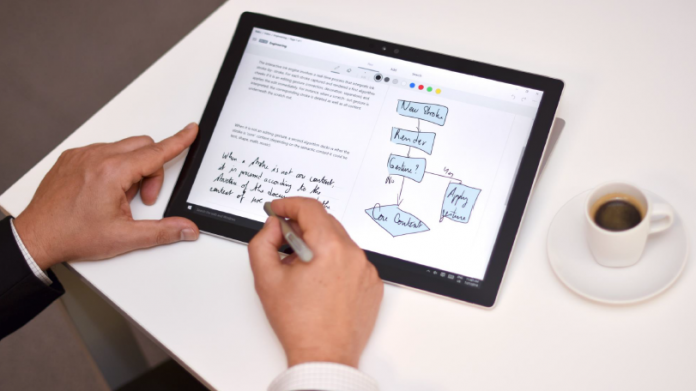Handwriting technology moved forward in a big way in 2017. Hardware vendors were cognizant that handwriting capable 2:1 tablets had been the only growth sector of the tablet market in 2016. Since 2:1 tablets almost always included an option for an active pen—which exploits the latest handwriting interpretation technology and offers the most natural way for a user to interact manually with devices—this became an important new area of focus.
Google’s Pixelbook helped lead the 2017 charge with a tablet whose pen virtually eliminates ink lag, the dreaded delay in digital ink appearing behind the pen’s current position. The Pixelbook and Google Pen are both built specifically for the growing number of people taking advantage of today’s advanced handwriting tech. A new generation of stylus enabled devices, including offerings from all major suppliers such as the Samsung Chromebook Pro, specifically designed, as Buzzfeed put it, to challenge and take share from Microsoft’s Surface Pro and Apple’s iPad Pro. The active pen has now emerged as a welcome way to interact with the device. Rich Miner, Android co-founder, predicted at the futurewrite(); 2017 conference keynote address that in time the keyboard will take a back seat to users’ demand for the device to adapt more to the user.
What’s going on with this market? — and what will we see in 2018 and beyond? Here’s a quick look.
Driving Factors: Mobility, Multi-modality & Productivity
Three big trends driving the development of computing hardware are the need for mobility, the desire for multimodal input and the need for increased productivity. In a single day, a road warrior executive – or, for that matter, a health care professional, field sales person, educator, student, consumer or car driver – might find themselves using three or more input methods to enter and manipulate data on their devices. These generally will include voice, typing and handwriting: Someone might dictate instructions to associates in the morning, take handwritten notes at a meeting during the day and type up a report at night.
Hardware that offers all these options has become a requirement – hence the growth in the detachable or foldable tablet category. Software that can interpret handwriting in almost any form, as well as format, edit, store and share handwritten data as standard digital files dramatically enhance productivity. With active pens that enable these capabilities common from all suppliers, this software is rapidly gaining in popularity.
Step into almost any business meeting and you’ll most likely find someone presenting via some sort of slide presentation and then likely find a table full of people typing away on their laptops. But a growing body of evidence shows that individuals actually comprehend and remember less when they type notes during a meeting than when they take handwritten notes. Keyboard written notes, it turns out, tend to be mere transcriptions; handwritten notes tend instead to call out key points, organize and summarize which stimulates memory.
Given the cutting-edge features of today’s handwriting technology, not only can today’s professionals and students easily integrate handwriting with the rest of their digital workflow, many have found that relying on handwriting as an input method is not only more intuitive, but can also boost productivity. It even allows these handwritten documents to be shared via the cloud and be edited, formatted using a variety of devices on all popular operating systems. Handwriting is also the easiest way to create diagrams, mind maps or enter and solve mathematic equations.
Coming Soon: Advanced Capabilities
In 2018, look for handwriting tech to not only become simpler to use and more tightly-integrated with current digital document technology, but to add value in arenas many folks don’t traditionally correlate with writing at all. Some examples:
- Handwriting in cars. In the last three to four years, higher-end auto manufacturers like Audi, Mercedes and Tesla models began shipping cars with embedded handwriting technology. There are already 4 million vehicles on the road that use handwriting input to lower driver distraction during interaction with the vehicle while it is on the move. But that was just a start. According to Frost & Sullivan, the market for handwriting technology in cars will grow at a rate of more than 34 percent each year through 2020. By 2018, its analysts say, you should expect to find handwriting technology interfaces included in a broader range of vehicles and price points, from manufacturers of many of the most popular mid-range sedans.
- AI-enabled simplicity. Look for super imposed handwriting to be included on smart keyboards, including fuzzy tapping and smooth typing. The next step is to be able to write on the keyboard and let the user decide the desired input method for the task at hand. Expect predictive text to be enhanced. Transliteration capabilities, already common in some vehicles, will expand quickly. Count on fully flexible advanced handwriting recognition, too – software that recognizes superimposed characters, cursive input or even handwriting written over multiple lines.
- Active stylus enabler. Today, some 70 percent of us spend at least an hour writing by hand. That number will likely increase – simply because people can do so much more with both a great stylus and technology providing handwritten interpretation into digital form. According to Variant Market Research, the size of the global digital pen market is set to grow to some $4.2 billion by 2024, growing at a compound annual growth rate of 17.8 percent from 2016 to 2024. The global handwriting recognition (HWR) market is US $1,039.3 million, and is expected to grow at a CAGR of 15.7 percent by 2025.
- Pervasive handwriting. Interactive Ink is the technology that enables users to interact with what is written on the device. Users can now manipulate, format and edit the digital ink which was never previously possible. This new freedom for handwritten documents to integrate with the existing workflow is demonstrating huge productivity gains for the user. Today’s tablets and other mobile devices now can quickly integrate diagrams and math equations into business documents. Look soon for the ability to capture an even larger variety of diagrams, charts, mind maps and even more mathematical equations to be solved solely using the pen.
Tomorrow’s handwriting interpretation software using Interactive Ink technology will offer enhanced productivity and increased flexibility for use in varied environments. Best of all, you’ll see that technology increasingly integrated and expected in more and more mainstream business applications.
Find a Home-Based Business to Start-Up >>> Hundreds of Business Listings.

















































